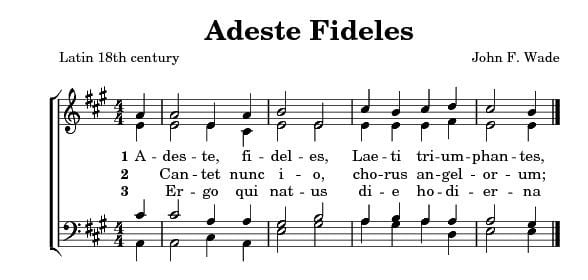 | ||
The term "four-part harmony" refers to music written for four voices or for some other musical medium—four musical instruments or a single keyboard instrument, for example—where the various musical parts can give a different note for each chord of the music.
Contents
The four main voices are typically labelled as: soprano (or treble), alto (contralto or countertenor), tenor, and bass. Because most singers have a relatively limited range, the upper notes of the soprano or tenor part cannot be sung by a bass singer. Conversely, the lower notes of the bass part typically cannot be reached by a soprano voice, with some notes so low that alto and tenor voices cannot reach them either.
Even groups of just four people, singing as quartets, can perform in four-part harmony.
In European classical music
In the baroque era, a set of rules developed for voice leading in four-part harmony. The bass voice would be assigned the root of the chord, although it would occasionally be assigned to the fifth. If the chord is a triad, the root is generally double by one of the other voices. Voices never cross; that is, the soprano part would always be the highest in pitch, the next highest would be the alto, next the tenor, and the bass would be lowest. When two voices harmonized in perfect intervals, they were forbidden from staying in the same perfect harmony in the next chord, also known as moving in parallel. Another rule concerns authentic cadences. In such cadences, the leading tones are required to resolve to the tone a half step away. That is, the voice that plays the 7th must also play the resolution up to the tonic, and if the fifth chord is a dominant seventh, the fourth must resolve down to the third. These rules are still obeyed now in strict four part harmonizations, although most compositions now apply less strict forms of voice leading.
Genres
Four parts for instruments
Some music is written, in four-part harmony, for small groups of only four instruments, such as a string quartet, a brass quartet, or a woodwind quartet. For instance, string quartets sometimes feature four part harmonizations, with the violins playing the top two parts, the viola playing the tenor part, and the cello taking the bass part.However, due to the range of musical instruments covering more pitches than a typical human voice, a quartet might play some harmonies with very high notes or very low notes, rather than the blended range of choral music.
Beyond quartets, in large orchestras or musical bands, the larger sections of instruments, such as violins, cellos, clarinets, flutes, trumpets, or French horns often have music written in four-part harmony. Similar to vocal music, the first part for a section of instruments typically plays the melody line, in some passages of a composition, with the other parts playing the supporting harmonies. The third part is often a harmonic mirror of the first part, which will sound somewhat melodic as well (if played separately). However, the second and fourth parts usually play close harmonies, in a more monotonous range, and rarely sound as melodic as the third part. Because musical instruments typically have a wider range than a human voice, any instrument in each section of a band or orchestra is able to play any of the four parts, although the first part often has high notes, or faster notes, that only a more experienced musician can play well.
